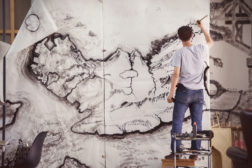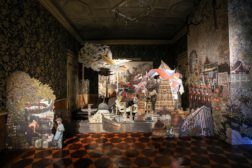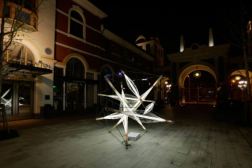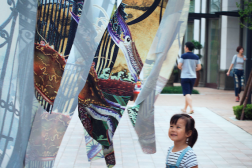
Palermo Pavilion featured at the 9th Shanghai Biennale
Palermo Felicissima, Inter-City Pavilion
Text by Laura Barreca and Davide Quadrio
Palermo and City Pavilions
The City Pavilion, a new exhibition format of Biennale this year, involves only 30 cities worldwide and Palermo is one of them. Paraphrasing the intervention of Charles Esche, one of the curators of the project, during the curatorial summit that was held at the Witte de With in Rotterdam June 28th, 2012: “the city represents the individual in his uniqueness, not a national identity charge of a figurative sense of collective political power; national identity is the identity made for unitary nationalist purposes.” In the city area this impulse is reduced or absent. The idea is not to represent a national identity, but to relate Shanghai to other cities, to other unique communities. Palermo, with its ancient culture, has always been a melting pot of Mediterranean cultures, a “felicissimo” place from this point of view and, more in general, in line with the curatorial idea of City Pavilions.
Exhibition
Palermo Felicissima, name taken from the homonymous text dedicated to the cultural and monumental heritage of Palermo, written in 1932 by the Sicilian historian Nino Basile, is based on the restitution of a contemporary image of Palermo, sort of a reconstruction of the avant-garde spirit that made Palermo famous in the 20th century, as the capital of the Liberty style, the capital of fashion and of industrial design. Decay and abandon naturally followed after the bombing in WW II, but a place of freedom was also born. This sense of freedom made Palermo a tourist and artistic attraction for those artists that decided to move there in the last years and wanted to give a contemporary image detached from the “leopard” stereotype that often forced a condition of cultural paralysis.
The exhibition is an existential way, a sort of travel to discover the identity, the atmosphere, the amazing contradictions that make Palermo unique among the cities of the world. Manfredi Beninati, an artist form Palermo, rebuilds a stage set, visible by two little windows, where the ruins of the past glory turn into a faded image of a hall from an aristocratic building. The artwork of Francesco Simeti is a setting with a wall-paper inspired by the Liberty style, wherein the artist shows the splendor and the contradictions of the Belle Epoque of Palermo at the beginning of the century, reusing Francesco Lojacono’s Sicilian landscapes and sights.
The work of Massimo Bartolini Starless is a huge sculpture made of “luminarie,” typical of the Sicilian streets during holidays, stars falling and picked up in an installation on the floor. In the performance video of Vanessa Beecroft VB 62, behind the sculptures that are reminiscent of Serpotta, we have the background of Santa Maria dello Spasimo, one of the most beautiful Churches in town. Forma Fantasma is a duo of designers based in Eindovhen, that describes the typical stratification of the Mediterranean people and the contemporary stories of migrants who keep crossing it through the work Moulding Tradition.
Lee Kit, Chinese artist, has spent a period in Palermo and he will show the result of his personal experience by recreating the simple and friendly interior of Bar Massaro, one of the places his memory of Palermo is particularly connected to. In the same way Guo Hongwei will exhibit a Portion of Sea (A page of Ocean), a metaphor for the link between different continents and cultures that have always been gathered together by water. Following the buildings described by Nino Basile in his Palermo Felicissima, Stefania Galegati imagines her Greetings from Palermo, a set of city postcards, a contemporary vision of everyday life. Laboratorio Saccardi, in a medieval polyptyc with a simple language, tells Jesuits’ courses in XVII from Sicily to China, to show nonstop religious, commercial and cultural trades between Italy and the East.
The idea of Palermo is also within the images of the contemporary theater of Emma Dante who, through a theatrical structure made of actions, winks and grimaces/faces, manages to stage the metaphor of the genius loci, through the complexity and mysterious characters that feed and make Palermo an absolutely attractive place. In 1989, Pina Bausch brought his dance-theater to the Sicilian capital: Palermo Palermo was born from that experience, one of the most exciting performances, able to express the identity of people and the many souls of our city.
Conclusion
Art, used for social change, often sounds like a sentence from the past, far away and too idealistic. Yet today, it becomes a founding and necessary consideration for the construction of a new identity, starting from the heritage of the past. Art, as well as culture in general, can and should be able to provide a benchmark from where to rebuild the credibility of a city like Palermo. It is fortunate to have within itself some of the greatest treasures in the world, and especially a potential of renewal and energy within the territory, that has been lacking a real sense of enhancement in the international context for so long. Investing in art is a necessary step to give back to our city a crucial and decisive role in the Mediterranean, as a center of outreach and cultural exchange, in a dialogue between East and West. A society which is not able to imagine anything except its present, is a decadent society. The chance offered by the Shanghai Biennale to Palermo is unique indeed and it will be an opportunity, through art’s universal language, to convey new meanings and new ways of communication with other realities in the world.




